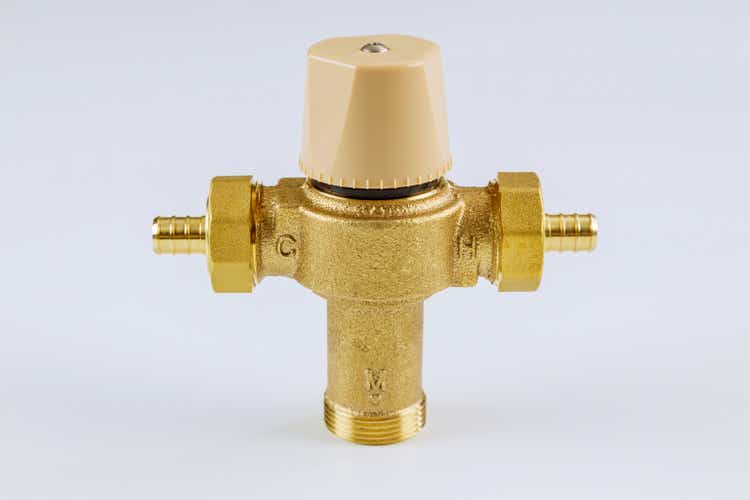photovs/iStock via Getty Images
Writing about Watts Water Technologies (NYSE:WTS) (“Watts”) in late February, I said I preferred to wait in the hopes of seeing an even better entry price. The shares continued to slide through late June to mid-July, bottoming out below $117 before rebounding nicely since those doldrums.
I’ve been impressed with the execution at Watts, as management has leveraged a healthy retrofit/renovation market and improving new construction markets to gain share. I’m even more impressed with the strong margin execution against a backdrop of input and distribution cost pressures. As far as criticisms and concerns go, I do have some concerns about the impact of higher rates on new-builds, as well as a declining tailwind from renovation projects spurred by the pandemic. Valuation isn’t superb, but this is a quality name leveraged to construction growth (balanced between non-residential and residential) and trends like energy efficiency and loss prevention.
Strong Execution Even Against Tougher Comps
Watts Water’s second quarter results were impressive to me. Revenue rose 16% year over year on a +32% year-ago comp (tied to freezing weather in the southern U.S.), including 22% year-over-year growth in the Americas segment. Overall revenue beat expectations by 7%, though growth did slow in Europe and APMEA from the mid-teens to 5% and 3%, respectively.
Gross margin improved 260bp (to 45.4%) and was well ahead of expectations. While Watts is not immune to input cost pressures, the company has been using its balance sheet to offset some of these challenges and the company benefited from lower-cost inventory (as well as overhead/scale benefits).
Operating income rose 40% on an adjusted basis (margin up 360bp to 18.5%), while segment profits rose 67% (margin up 670bp to 20.6%). While the Americas region remains the leader (profits up 55%, with margin up 470bp to 22.7%), the 15%-plus margins in Europe and APMEA are both solid (though APMEA margin was down almost three points to 15.8%).
With strong year-to-date performance, management meaningfully upgraded guidance for the year, with the midpoint for organic revenue growth moving from 5.5% to 9.5% and the midpoint for adjusted operating margin improvement moving from 40bp to 135bp.
Strong Demand In North America, But The Tailwinds Could Be Fading
Watts has been benefiting from both healthy residential and non-residential markets across both new-builds and repair/replace in North America, but there is some evidence of slowing demand.
Higher rates are cooling off the housing market, with July housing starts down 10% to the lowest level since June 2020, and the renovation market likewise seems to be peaking. Multifamily is likewise showing signs of cooling off, though I expect this to be a modest correction given the ongoing housing deficit across the United States (and I’d say the same about single-family as well).
Non-residential has held up better; renovation activity is starting to slow some here, but new-builds are still quite healthy and while recent ABI and Dodge Momentum Index data show mixed trends – July ABI of 51.0 versus June 53.2 and July DMI of 178.7 versus June 173.6, the indicators are still in expansionary territory. Watts isn’t quite as leveraged to institutional markets like education that I think could be a little stronger in FY’23, but commercial growth in the neighborhood of 4% still wouldn’t be bad.
Watts is also seeing increasing challenges outside North America. Higher rates and higher energy costs are undermining confidence in Europe and that is likely to translate into slower construction and renovation activity.
Ongoing Leverage To Smart Devices And Efficiency Initiatives
As I mentioned in a recent article on Zurn Elkay (ZWS), I believe leak detection (broadly defined) could be a solid growth opportunity. The company recently highlighted products like the Sentinel Leak Defense system (whole-home leak protection for single-family) and Blucher monitoring roof drains in investor presentations, and management has reiterated its target of 25% revenue contributions from smart/connected devices (although the target date has been pushed out a year to 2024).
Why do I think this could be a growth opportunity? Rising loss severity has been cited as an issue by most personal and commercial P&C insurance companies, as inflation has driven up the cost of parts and labor, and insurance companies are looking for ways to mitigate these costs. Incentivizing property owners to retrofit (or install on new-builds) leak detection technologies is a cost-effective way to reduce loss frequency and severity.
Watts also has leverage to increase attention to energy efficiency. High-efficiency commercial boilers and water heaters, as well as radiant/hydronic heating products for commercial and residential markets, are getting more attention as green building initiatives prioritize more energy-efficient systems.
The Outlook
I had higher expectations for Watts going into the year, so my modeling changes in response to the recent financial outperformance aren’t quite as dramatic. I’m also a little concerned about the impact of inflation and interest rates on new-builds over the next 12-18 months, but I think the construction markets (particularly the single-family and multifamily markets) will digest those higher rates and continue growing beyond some potential disruption in 2023.
I’m still looking for long-term core revenue growth of around 5% from Watts, with steady FCF margin leverage driving mid-to-high single-digit FCF growth. I’m also still using a 14.5x forward EBITDA multiple in recognition of Watts’ above-average margins and returns (ROIC, et al.).
The Bottom Line
I can’t say that Watts is tremendously undervalued, but it’s a well-run company leveraging growth in construction activity and outperforming on margins, so I wouldn’t expect it to be all that cheap. I think I prefer Zurn Elkay at today’s valuations, but it’s close to a “six of one, half-a-dozen of the other” argument, and while I’m not crazy about today’s valuation, it’s a close call.


Be the first to comment